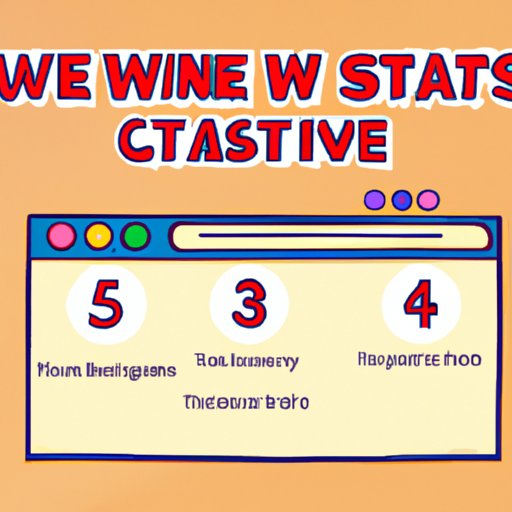
I. Introduction
Creating a website can be a daunting task, especially if you’re new to web design and development. But with the right tools and guidance, anyone can create a professional-looking website that meets their specific needs.
In this article, we’ll take you through the process of creating your own website, step by step. We’ll cover everything from choosing a domain name and selecting a platform, to designing your website and making it look professional. Whether you’re creating a personal blog or an e-commerce site, you’ll find all the information you need right here.
II. Step-by-Step Guide on How to Create Your Own Website
Creating your own website can be broken down into six main steps:
- Choose a domain name
- Select a platform
- Design your website
- Optimize your website for search engines
- Publish your website
- Maintain your website
Choosing a domain name
A domain name is the address of your website. It’s what people type in their web browser to access your site. When choosing a domain name, it’s important to pick something that’s easy to remember and reflects the content of your site. You’ll also need to choose a domain extension (e.g. .com, .org, .net, etc.)
There are several domain name registrars where you can purchase a domain name. Some of the most popular ones include GoDaddy, Namecheap, and Bluehost.
Selecting a platform
Once you have a domain name, you’ll need to select a platform for your website. There are many platforms available, but the most popular ones include WordPress, Wix, and Squarespace.
Each platform has its own strengths and weaknesses, so it’s important to do your research and choose one that fits your needs. Some factors to consider include ease of use, cost, customization options, and scalability.
Designing your website
The design of your website is crucial to its success. It should be visually appealing, easy to navigate, and reflect the content and purpose of your site.
If you’re using a website builder platform, you’ll have access to a range of templates and designs that you can customize to your liking. If you’re building your website from scratch, you’ll need to consider factors such as color scheme, font, page layout, and navigation.
Optimizing your website for search engines
Search engine optimization (SEO) is the process of optimizing your website to rank higher in search engine results pages. This involves using keywords, meta descriptions, and other techniques to make your website more visible and attractive to search engines.
If you’re using a website builder platform, many of these SEO features will be built-in. If you’re building your website from scratch, you’ll need to research and implement SEO techniques yourself.
Publishing your website
Once you’ve designed and optimized your website, the next step is to publish it. This involves connecting your domain name to your platform and making your website accessible to the public.
Most website builder platforms have built-in publishing tools that make this process easy. If you’re building your website from scratch, you’ll need to upload your files to a hosting provider and connect them to your domain name.
Maintaining your website
Creating a website is just the first step. To keep your website running smoothly and attract visitors, you’ll need to maintain it regularly. This involves updating content, fixing broken links, optimizing for search engines, and monitoring site traffic.
If you’re using a website builder platform, many of these maintenance tasks will be taken care of automatically. If you’re building your website from scratch, you’ll need to do these tasks yourself or hire a professional to do them for you.
III. The Tools You Need to Create Your Own Website
Creating a website requires several essential tools, including:
- Domain name registrar
- Website builder or web development software
- Hosting provider
- Content management system (CMS)
- Analytics tool
- Backup and security tool
Domain name registrar
A domain name registrar is a company that lets you search for and purchase domain names. Some popular domain name registrars include GoDaddy, Namecheap, and Bluehost.
Website builder or web development software
A website builder is a tool that lets you create a website without needing any coding knowledge. Some popular website builders include Wix, Squarespace, and WordPress.
Web development software, on the other hand, requires coding knowledge and is used to build websites from scratch. Popular web development software includes Adobe Dreamweaver, Visual Studio Code, and Sublime Text.
Hosting provider
A hosting provider is a company that stores your website’s files and makes them available on the internet. Some popular hosting providers include Bluehost, HostGator, and SiteGround.
Content management system (CMS)
A content management system (CMS) is software that lets you manage your website’s content, such as blog posts, images, and videos. WordPress is the most popular CMS, although other options include Drupal and Joomla.
Analytics tool
An analytics tool lets you monitor your website’s traffic and track user behavior. Google Analytics is the most popular analytics tool, but other options include Adobe Analytics and Piwik.
Backup and security tool
A backup and security tool ensures that your website’s files are backed up regularly and protected from hackers. Some popular backup and security tools include Jetpack, VaultPress, and Wordfence.
IV. Expert Tips on How to Create a Professional Website
To make your website look professional, it’s important to consider factors such as color scheme, font, page layout, and navigation. Here are some expert tips:
- Choose a color scheme that reflects your brand and is easy on the eyes.
- Pick a font that is easy to read, especially for longer paragraphs of text.
- Keep your page layout clean and uncluttered, with plenty of white space.
- Make sure your website is easy to navigate, with a clear menu and logical hierarchy.
- Use high-quality images and graphics that complement your content.
V. DIY Website Creation: Tips for Beginners
If you’re new to website design and development, don’t worry. Here are some tips to get you started:
- Choose a website builder platform that is easy to use and has plenty of tutorials and support.
- Research other websites in your niche to get ideas for layout and design.
- Keep your website simple and easy to navigate.
- Use high-quality images and graphics.
- Focus on creating great content that is valuable to your audience.

VI. 5 Easy Steps to Create Your Own Website
If you’re looking for a simplified version of the website creation process, here are five easy steps:
- Choose a domain name and register it with a domain name registrar.
- Select a website builder platform and sign up for an account.
- Pick a template and customize it with your own content and images.
- Publish your website and connect it to your domain name.
- Maintain your website regularly by updating content and monitoring traffic.
VII. Creating a Website From Scratch: Everything You Need to Know
If you’re interested in building your website from scratch, here’s a breakdown of the process:
- Plan your website’s structure and design
- Choose a development environment and program your website’s code
- Integrate your website with a content management system (if desired)
- Publish your website and connect it to your domain name and hosting provider
- Maintain your website by updating code and content as needed
VIII. The Ultimate Guide to Creating Your Own Website
By now, you should have a good idea of how to create your own website, whether you’re a beginner or an experienced web developer. Remember to choose a domain name that reflects your brand and use a website builder platform or web development software to design your site.
Make sure your website is optimized for search engines and is easy to navigate. Use high-quality images and graphics and focus on creating great content that is valuable to your audience.
Finally, maintain your website regularly to ensure it continues to attract visitors and serve its purpose. Whether you’re creating a personal blog or a business website, with the right tools and guidance, you can create a website that meets your needs and reflects your unique vision.
IX. Conclusion
Creating your own website is important for various purposes, such as personal branding, online portfolio, blogging, and running an e-commerce site. It gives you a platform to showcase your work, express your opinions, and connect with your audience.
Thank you for reading this guide on how to create your own website. We hope you found it helpful and informative. If you have any questions or feedback, please don’t hesitate to contact us.





